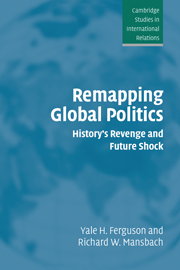Book contents
- Frontmatter
- Contents
- Preface
- Acknowledgments
- 1 Postinternational politics
- 2 Theory and method
- 3 Political space and time
- 4 States and other polities
- 5 Identities in a postinternational world
- 6 A postinternational world economy
- 7 War in a postinternational world
- 8 Technology and change
- 9 The future
- Index
- CAMBRIDGE STUDIES IN INTERNATIONAL RELATIONS
7 - War in a postinternational world
Published online by Cambridge University Press: 22 September 2009
- Frontmatter
- Contents
- Preface
- Acknowledgments
- 1 Postinternational politics
- 2 Theory and method
- 3 Political space and time
- 4 States and other polities
- 5 Identities in a postinternational world
- 6 A postinternational world economy
- 7 War in a postinternational world
- 8 Technology and change
- 9 The future
- Index
- CAMBRIDGE STUDIES IN INTERNATIONAL RELATIONS
Summary
War, as we have observed, has been central to theorists and practitioners of global politics, and violence has been a feature of global life since history has been recorded. Whatever the methodology or theoretical assumptions employed, any effort to explain the causes, nature, and probable future of war has always been fraught with serious difficulties. Even defining it is problematic. Surveying the relevant literature in 1993, John Vasquez concluded that the scientific study of war had not advanced very far, in part because data gathering had often proceeded on the shaky theoretical foundation of realist theory. There have been few subsequent breakthroughs, and they will become still more elusive as we move further into the postinternational epoch with its weakened states, proliferation of non-Westphalian polities, globalizing technologies, new identities, and fundamentalist ideologies. Certainly the recent literature on the so-called democratic peace is plagued with internal problems and is fatally state-centric.
One perennial and central difficulty has been the definition of war itself: violent conflict now ranges from potential nuclear exchanges to interstate “conventional war,” “civil war,” “proxy war” (with state or nonstate proxies), “guerrilla war,” “ethnic cleansing,” “tribal” warfare, and “terrorism” perpetrated against innocent civilians by individuals (e.g., suicide bombers) and groups (e.g., Al-Qaeda or Hamas). Actual conflicts not only overlap some of these categories but also, importantly, vary enormously in their intensity and duration.
- Type
- Chapter
- Information
- Remapping Global PoliticsHistory's Revenge and Future Shock, pp. 227 - 272Publisher: Cambridge University PressPrint publication year: 2004

